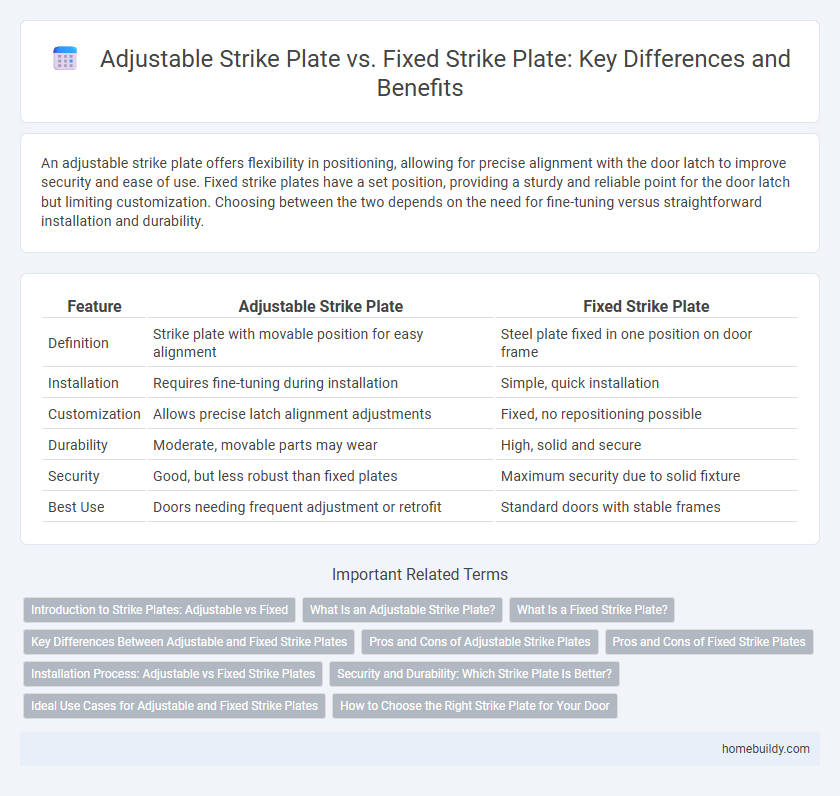An adjustable strike plate offers flexibility in positioning, allowing for precise alignment with the door latch to improve security and ease of use. Fixed strike plates have a set position, providing a sturdy and reliable point for the door latch but limiting customization. Choosing between the two depends on the need for fine-tuning versus straightforward installation and durability.
Table of Comparison
| Feature | Adjustable Strike Plate | Fixed Strike Plate |
|---|---|---|
| Definition | Strike plate with movable position for easy alignment | Steel plate fixed in one position on door frame |
| Installation | Requires fine-tuning during installation | Simple, quick installation |
| Customization | Allows precise latch alignment adjustments | Fixed, no repositioning possible |
| Durability | Moderate, movable parts may wear | High, solid and secure |
| Security | Good, but less robust than fixed plates | Maximum security due to solid fixture |
| Best Use | Doors needing frequent adjustment or retrofit | Standard doors with stable frames |
Introduction to Strike Plates: Adjustable vs Fixed
Adjustable strike plates offer customizable alignment, enhancing door security and ease of lock installation by allowing precise positioning to accommodate frame variations. Fixed strike plates provide a rigid, permanent alignment that ensures stability but lack the flexibility to adapt to door or frame irregularities. Choosing between adjustable and fixed strike plates depends on factors such as door type, installation complexity, and the need for long-term adjustment.
What Is an Adjustable Strike Plate?
An adjustable strike plate is a hardware component designed to provide flexible alignment for door locks, allowing fine-tuning to accommodate variations in door and frame positioning. Unlike fixed strike plates, which have a static position and require precise installation, adjustable strike plates can be moved vertically or horizontally to ensure the latch or bolt engages securely without forcing the door. This adaptability enhances door security and functionality by reducing misalignment issues often caused by settling or warping of the door frame.
What Is a Fixed Strike Plate?
A fixed strike plate is a rigid metal plate mounted on a door frame that receives the latch bolt, providing a secure point of contact to keep the door closed. Unlike adjustable strike plates, it cannot be moved or repositioned once installed, which makes it simpler but less flexible for aligning with the door latch. Fixed strike plates are typically made from steel or brass to ensure durability and reinforced protection against forced entry.
Key Differences Between Adjustable and Fixed Strike Plates
Adjustable strike plates offer flexibility in alignment, allowing for precise door latch positioning to enhance security and ease of use, while fixed strike plates have a permanent, non-moveable design that requires exact door framing during installation. Adjustable options accommodate settling or shifting of door frames over time, reducing the need for hardware replacement, unlike fixed strike plates that may become misaligned and compromise lock effectiveness. Material durability and installation complexity also differ, with fixed strike plates typically providing a more robust, secure fit and adjustable plates offering convenience and adaptability.
Pros and Cons of Adjustable Strike Plates
Adjustable strike plates offer flexibility in alignment, making them ideal for doors that may settle or shift over time, which reduces the need for frequent adjustments or costly repairs. They provide easier installation and enhanced security by allowing precise positioning to ensure the latch or bolt fits perfectly in the strike plate. However, adjustable strike plates can be more expensive than fixed ones and might have more moving parts, potentially leading to durability concerns over long-term use.
Pros and Cons of Fixed Strike Plates
Fixed strike plates offer reliable durability and consistent alignment with the door latch, enhancing security by providing a solid, immovable surface for the lock bolt to engage. Their installation is straightforward and cost-effective, making them a practical choice for standard door setups without the need for frequent adjustments. However, fixed strike plates lack flexibility, which can result in misalignment issues over time due to door frame settling or movements, potentially leading to lock malfunction or increased wear.
Installation Process: Adjustable vs Fixed Strike Plates
Adjustable strike plates offer a flexible installation process, allowing fine-tuning to align perfectly with the latch, reducing the need for precise measurements and minimizing door frame modifications. Fixed strike plates require accurate initial placement and may involve chiseling or mortising the door frame to ensure the latch fits securely, making the installation more rigid and time-consuming. The adjustability feature in strike plates enhances compatibility with various door and latch types, simplifying maintenance and future adjustments.
Security and Durability: Which Strike Plate Is Better?
Adjustable strike plates offer enhanced security by allowing precise alignment with the door latch, reducing the risk of forced entry, whereas fixed strike plates, while simpler, may leave gaps that compromise door integrity. Durability favors adjustable strike plates made from reinforced materials like heavy-duty steel, which withstand repeated impacts and maintain alignment longer than fixed options. For optimal security and long-term durability, adjustable strike plates with robust construction provide a superior solution compared to fixed strike plates.
Ideal Use Cases for Adjustable and Fixed Strike Plates
Adjustable strike plates offer precise alignment for doors with frames that have shifted or settled, making them ideal for older homes or structures prone to frequent movement. Fixed strike plates provide a durable, stable option suited for new construction or well-aligned door frames where minimal adjustment is needed. Choosing between adjustable and fixed strike plates depends on the door frame condition and the requirement for long-term latch alignment stability.
How to Choose the Right Strike Plate for Your Door
Choosing the right strike plate for your door depends on the level of flexibility and security required. Adjustable strike plates offer customizable positioning to accommodate door frame irregularities and improve latch alignment, enhancing security and ease of use. Fixed strike plates provide a sturdy, permanent installation ideal for standard door settings and maximum resistance against forced entry.
adjustable strike plate vs fixed strike plate Infographic

 homebuildy.com
homebuildy.com